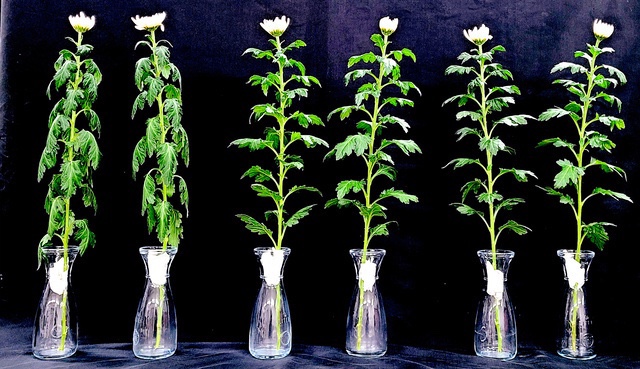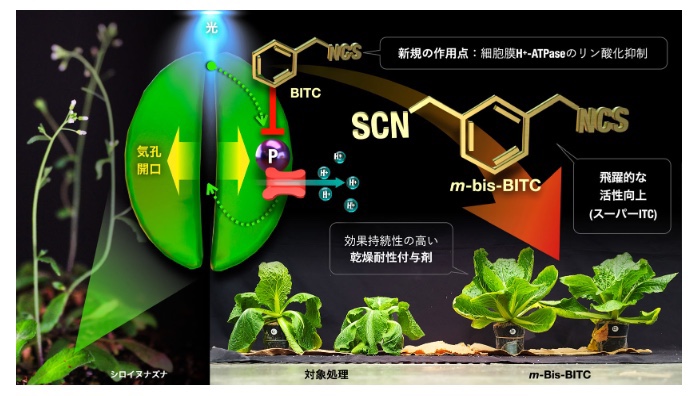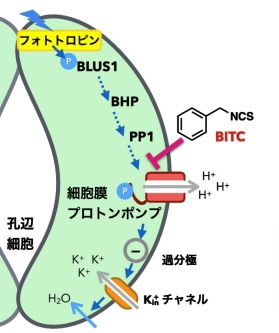
切好的菊花瀝乾水分後1.5小時。
應用 BITC (3, 4) 和 Super ITC (5, 6) 與未處理(左起 1, 2)的對比。照片提供:名古屋大學(朝日新聞)
芥末辣味成分:保持蔬菜的新鮮度!
– 用於保鮮葉類蔬菜和切花 –
名古屋大學和關西學院大學:
我們專注於植物葉片表皮中的“用於水分和氣體交換的氣孔”。
我發現了一種可以阻止“氣孔”打開的天然物質。
是山葵等的辛辣成分之一,用於葉類蔬菜和切花的保鮮。
(Asahi Shimbun Digital)-雅虎新聞
https://news.yahoo.co.jp/articles/db7946bf5144d968c0eab216139f0c060bb9c020

與左邊兩種相比,塗有Super ITC的大白菜(右邊兩種)的萎蔫明顯減少。(照片提供:名古屋大學)

新發現的防止植物枯萎的天然產物!
~真實身份為辛辣成分,通過分子修飾可實現廣泛的應用~
名古屋大學生物分子科學研究所:關西學院大學理學院
我們發現了一種抑制植物氣孔開放的天然物質,並成功開發了一種可大大提高植物活性的分子。
抑制因乾燥引起的葉片枯萎:
當將該化合物噴灑在種植在土壤中的菊花和大白菜的切花上時,發現“抑制了因乾燥引起的葉子枯萎”。
農作物的耐旱性:
有望用作切花、插花的保鮮劑和農產品的抗旱劑。
研究成果:
2023 年 5 月 15 日在線發表於 Nature Communications。
氣孔開放抑製劑的發現:
我們發現異硫氰酸芐酯 (BITC) 是油菜籽中含有的一種天然產物,可作為氣孔開放抑製劑。
發現該化合物抑制“氣孔打開引擎/細胞膜質子泵的功能”並阻止氣孔打開。
日本研究.com
https://research-er.jp/articles/view/122036

Identification and improvement of isothiocyanate-based inhibitors on stomatal opening to act as drought tolerance-conferring agrochemicals
Nature Communications
Abstract
Stomatal pores in the plant epidermis open and close to regulate gas exchange between leaves and the atmosphere.
Upon light stimulation, the plasma membrane (PM) H+-ATPase is phosphorylated and activated via an intracellular signal transduction pathway in stomatal guard cells, providing a primary driving force for the opening movement.
To uncover and manipulate this stomatal opening pathway, we screened a chemical library and identified benzyl isothiocyanate (BITC), a Brassicales-specific metabolite, as a potent stomatal-opening inhibitor that suppresses PM H+-ATPase phosphorylation.
We further developed BITC derivatives with multiple isothiocyanate groups (multi-ITCs), which demonstrate inhibitory activity on stomatal opening up to 66 times stronger, as well as a longer duration of the effect and negligible toxicity.
The multi-ITC treatment inhibits plant leaf wilting in both short (1.5 h) and long-term (24 h) periods. Our research elucidates the biological function of BITC and its use as an agrochemical that confers drought tolerance on plants by suppressing stomatal opening.